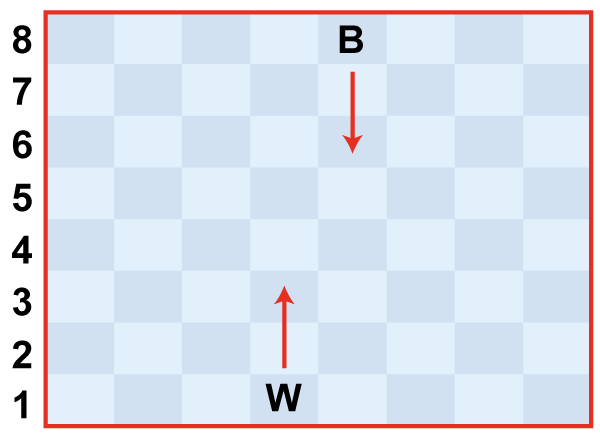Capture the Pawns Problem in Java"Capture the Pawns" is a classic chessboard problem that challenges programmers to develop a solution for finding the minimum number of moves required to capture all pawns on a given chessboard. In this problem, a chessboard of size N x N is considered, and the task is to determine the optimal sequence of moves to capture each pawn while adhering to the rules of chess movement. 
Approach:When it's the white pawn's turn, the game checks if it's located on the 8th row. If so, it signifies a win for Black, since the white pawn cannot make any more moves. Similarly, if the black pawn's turn comes and it's on the 1st row, this results in a victory for White, as the black pawn has no remaining moves. A check is made for adjacency with the black pawn diagonally during the white pawn's turn. If adjacent, the white pawn captures the black pawn, resulting in a win for the White; otherwise, the white pawn moves forward one step if the destination is unoccupied. A similar process is applied during the black pawn's turn, with adjacency checks and forward movement, potentially leading to a win for the black or a loss if no valid moves are available. Algorithm:Step 1: Set the initial positions of the white pawn (rowWhite, colWhite) and the black pawn (rowBlack, colBlack). Step 2: Initialize counters for the number of moves for white and black (whiteMoves, blackMoves). Step 3: Set a boolean variable to control the turn-based moves (isWhiteTurn = true). Step 4: Enter a loop that alternates between white and black moves until a winner is determined. Step 5: Check if it's the white player's turn (isWhiteTurn is true). Check if the white pawn can move forward (rowWhite != 8).
Step 6: Check if it's the black player's turn (isWhiteTurn is false). Check if the black pawn can move forward (rowBlack != 1).
Step 7: After each complete turn (white and black move), toggle the turn (isWhiteTurn = !isWhiteTurn). Step 8: After the Loop, check if whiteMoves are greater than blackMoves.
Implementation:Filename: ChessGame.java Output: White wins by capturing Black's pawn! Time Complexity: The code has a time complexity of O(n) due to the Loop, where n represents the number of rows on the chessboard. Space Complexity: The space complexity is O(1) as the amount of extra space used by the algorithm remains constant regardless of the input size.
Next TopicCompact Profiles Java 8
|
 For Videos Join Our Youtube Channel: Join Now
For Videos Join Our Youtube Channel: Join Now
Feedback
- Send your Feedback to [email protected]
Help Others, Please Share









